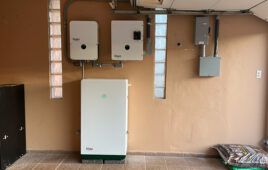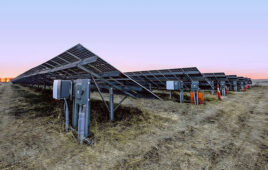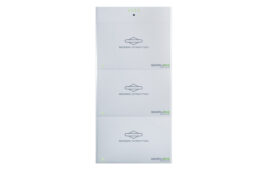“This tracker simulation isn’t working, the results are way too low. I should be seeing a 15 to 20% boost.”
That is one of the most common complaints that we hear, now that HelioScope has trackers in beta. And while there isn’t a bug in the calculations, this confusion actually reflects a deep and important trend that is impacting system designers across the board, and changing the cost-benefit of tracker systems.
As hardware costs continue to decline, designers are squeezing more solar modules into every system. By shrinking the spacing between the rows of modules, they get larger systems — maximizing overall energy production, and improving the cost-benefit of the array.
However, the tighter spacing has very different effects depending on whether the array uses fixed-tilt racking, or a tracker system. And ultimately, the tracker systems’ performance advantage versus fixed-tilt systems shrinks in this new design paradigm.
As a result, the rules of thumb for tracker performance advantages that were appropriate 5 to 10 years ago are becoming outdated today. Specifically, the “15 to 20% energy yield improvement” may no longer be true.
The comparison
Let’s first look at the fixed-versus-tracker comparison in the ‘old’ paradigm of wide spacing between rows. In Charlotte, comparing a fixed-tilt system to a tracker at a 24’ row spacing (representing a 0.2 ground coverage ratio, or “GCR”), the tracker improves yield approximately 15%, from 1,585 kWh/kWp to 1,815 kWh/kWp. In a sunnier Phoenix with the same designs, the tracker benefit is even higher, with a 20% performance advantage over fixed-tilt.
However, if we switch to closer spacing (spacing of approximately 6’, equivalent to a 0.5 ground coverage ratio), the tracker benefits compared to fixed-tilt become slimmer. All of the numbers fall, of course, as squeezing the modules closer together will naturally reduce the energy yield per watt of capacity. But the fixed-tilt systems fall only modestly (about 2% in both Charlotte and Phoenix), while the tracker yields fall more significantly, by 8-9%. As a result, the tracker yield advantage over fixed-tilt falls to about 8% in Charlotte and about 12% in Phoenix — in both cases, losing nearly half of the advantage.
The anatomy of tighter spacing
To understand why the two systems respond so differently, we look deeper at the performance calculations.
For the fixed-tilt scenarios, the main parameter that changes is the shading loss. This makes sense: as the modules are closer together, they shade each other more:

Figure 2: Fixed-Tilt Production Comparison. The primary difference between the systems is a ~2% difference in Shaded Irradiance
However, when we run the same analysis on a tracker system, we see very different behavior:

Figure 3: Tracker Production Comparison. The primary difference between the systems is a 5-6% reduction in Plane-Of-Array Irradiance
While the fixed-tilt arrays saw shading losses for the tightly-packed systems, the tracker system’s production decrease is mostly caused by POA losses — a difference of over 5% between the two cases.
Why does plane-of-array change? Backtracking.
The Plane-of-array (POA) calculation in solar modeling shows how much additional sunlight the modules get because of their tilt, compared to a flat module on the ground. This value can be zero (for a module with a tilt of 0°), is typically +3% to +15% for a fixed-tilt array (depending on the tilt) and can be upwards of +20% to +30% for a single-axis tracker array (since, in that case, the plane of the array actually tracks with the sun throughout the day). (The Plane of Array calculation can even be negative, if the array is pointed away from the equator.)
Coming back to the tracker production: the main reason for the drop in POA is the fact that tracker systems will backtrack to avoid row-to-row shading. At the beginning and end of the day, the tracker system will reverse the modules’ tracking in order to prevent them from shading each other. As a result, when the sun is at the horizon, the modules are actually flat (to avoid shading) rather than being tilted up at 90° (to be pointed directly at the horizon).

Figure 4: Illustrative image of backtracking at low sun angles. Courtesy SolarPro and Precision Solar Technologies
Note that when a tracker is backtracking, it is actually sacrificing its orientation toward the sun in order to prevent module shading. In general, this produces more energy than tracking the sun and incurring shade (and mismatch) losses.
For arrays with higher GCR values, backtracking happens more often and more significantly. When the tracker rows are spaced more closely together, they end up blocking each other later in the morning and earlier in the evening. A tracker system with a GCR of 50% will end up backtracking for over 1,720 hours over the course of a year, over a third of the operating hours of the array, representing about 25% of the array’s annual energy yield.
Backtracking means that the losses from tighter spacing in tracker systems show up in the “Plane of Array” (POA) step of the calculations. While this may make logical sense, this can lead to confusion: POA is the step where the tracker systems’ boost shows up. Yet with backtracking, this calculation essentially conflates two factors: the boost from trackers, and then the losses from backtracking.
Conclusion
Ultimately, tracker systems still make a ton of sense in a lot of locations, since the cost increase is often smaller than the yield increase. But today’s designers and developers would be wise to confirm their yield expectations based on the system location and design, rather than just based on their rule-of-thumb yield expectations.
Want to find out how you can calculate a tracker’s maximum tilt as a function of GCR? Check out our blog for a deeper look: http://blog.helioscope.com/the-shrinking-boost-of-single-axis-trackers/






The shade issue can be alleviated by a few concepts.
1: panels designed for shade, with tracking. The cells arranged in “stripes”, so each panel is composed of rows of cells, independent of each other. The top rows, unshaded, are primary, the bottoms are off or individually MPPT adjusted.
2: Using even odd setups where every other row is a true tracker, while the untrue trackers don’t enguage until the point where the other rows are no longer able to shade them.
Yes, there is a density problem, unless building on an incline. However, at the end of the day, tracking will always result in more power per square foot, and the losses from a simple tracker will always be neglagable. (Not true for complex trackers, which have high power draw, computerized controls and expensive replacement parts.)
I think gains from per-cell cooling would yield higher returns. (Over tilting so they capture more morning/evening light, while slightly inclined to reduce direct noon light, as well as heat-flow backings to exhaust heated air out, while drawing or fan-pumping in cooler air.) The additional tilt and spacing contributing to the greater cooling too.
Until they make glass that is highly IR reflective, and internally self diffusing, this will always be an issue. IR reflection so heat doesn’t build, and diffusing, so angle is almost irrelevant.
At the end of the day it comes down to money. If you don’t have the money for the cells, but you have the land for tilting without obstruction, then the answer is clear.
Another factor not ever taken into account is the end design of “losses over distance”. Cells spread out will demand more wire lengths, which increase power losses. In a flat system, wires can be fully shaded, without having to hurry them in the ground or build additional covers for the wires. With trackers, the majority of the wiring woul be unshaded or demand covering to reduce heating up from sun exposure, which also increases power losses.
The new systems which have a per-cell MPPT/inverter, bringing (any DC voltage) up to line-voltage, at increasing amps… Are the future of all systems. They reduce the need for heavy wires, reduce losses across the system, and yield similar returns to tracking, without tracking.
Paul, thanks for the article, focusing on yield is probably the most significant aspect of PV system economics. We agree with with many of your points, such as:
a) tracker gain vs fixed increases with GCR
b) “trackers make a ton of sense in alot of locations”
c) “designers and developers would be wise to confirm their yield expectations based on the system location and design”
However, all trackers are not the same, and for NEXTracker (NX), which has pioneered smart tracking, we see the relative yield gain & benefits vs fixed systems as INCREASING, not decreasing. Here’s why:
1) Adaptive Tracking:
NX systems have an options called TrueCapture (www.nextracker.com) that adaptively adjusts the angle of a tracker with respect to the elevation of its neighboring trackers, to eliminate inter-row shading. Fixed systems cannot do that. TrueCapture also reduces the angle in diffuse conditions, improving yield.
2) Bifacial
Trackers intentionally designed for bifacial significantly outperform bifacial gains of typical fixed systems, literally up to double the gain value. For some sites this could be +3-6% or more (in addition to normal tracker gains) vs fixed. Some trackers shade the back of modules with piers, bearings, drives, and again, these factors need to be accurately modeled. NX has empirically validated PVSyst input file recommendations for designers.
3) Snow (and dust) losses
Low tilt angle fixed systems have difficultly shedding snow. Losses attributable to snow accumulation are site and annual weather specific but can be very large, 3-5% or more for some sites. NX trackers actively address this with high rotation angle of +/-60 degrees, facilitating snow slide, and an imbedded feature called “Snow Shed” that actively dumps snow during a day of heavy snowfall. The NX Navigator GUI can also be used to stow trackers at 60 deg during a heavy dust storm such as seen in the middle east, reducing build up, and commencing normal tracking at storm conclusion.
4) Hail protection
The occurrence of extreme hail and weather has increased alarmingly over the last 2 decades. NX Navigator allows authorized operators to instantly stow the entire array at 60 degrees. This feature significantly reduces the mechanical impact of hail stones, and in most cases would eliminate module breakage that could wipe out the yield of a fixed system.
We agree that detailed modeling is essential. NX will continue publishing empirically validate results and working with the industry to evolve model accuracy on adaptive tracking, bifacial, and extreme weather factors.
Respectfully, Dan Shugar CEO / Founder
NEXTracker
Hi Dan, great points, and we very much agree. You guys have been very good about pushing the industry forward, and that often translates to new ways of driving value. What’s interesting is that these often create healthy challenges for us on the modeling side, either because the industry-level models are still being finalized, or because the causal relationships are proprietary. It’s what makes the solar industry generally, and the tracker product area in particular, so exciting!
Hi Dan, does Nextracker systems go into stow mode at night to help stopping snow build up at night?
Brian
“However, if we switch to closer spacing (spacing of approximately 6’, equivalent to a 0.5 ground coverage ratio), the tracker benefits compared to fixed-tilt become slimmer. All of the numbers fall, of course, as squeezing the modules closer together will naturally reduce the energy yield per watt of capacity. But the fixed-tilt systems fall only modestly (about 2% in both Charlotte and Phoenix), while the tracker yields fall more significantly, by 8-9%. As a result, the tracker yield advantage over fixed-tilt falls to about 8% in Charlotte and about 12% in Phoenix — in both cases, losing nearly half of the advantage.”
From long, long ago, the company that installed my first solar PV roof had been installing systems since the mid 1980’s. Their own hands on experience, suggested early on that tracking systems were not all that reliable or robust when compared to simple ground mount systems. Some military bases were implementing solar PV for back up power back then. It was found a more reliable system was ground mount fixed panels, with 20% more panels added to make up for the loss of tracking. At panel prices today around $0.50/watt or less when bought in bulk quantities, 20% more panels, less mechanical failure and even being able to increase daily yield by “tenting” ground mount solar PV facing East/West could be more cost effective over the long term than tracking systems. With the expected roll out of bifacial solar PV panels, back side energy harvest may make tracking unnecessary in many instances. The Northeast may be more cost effective with bifacial tracking arrays. In the desert Southwest, fixed ground mount arrays with an East and West fixed orientation using bifacial panels would be longer lasting and less problematic than arrays using tracking. With the more simple solar PV strings into string inverters, East/West array orientations allow longer (usable) energy generation during the day. Using bifacial solar PV panels could make up for some of the lost generation from side/back energy harvest and not having the arrays facing due south. From my own small home roof mount system that was split and used East facing panels and West facing panels created a longer solar harvest day over many years of operation, without mechanical failures. This orientation also seems to help during cloud cover events, when clouds blow through the region. One might make very good power during the morning hours off of the East facing solar PV and then the clouds move in and reduce the solar harvest from the West facing solar PV. When one averages out the power produced over the years, the East/West orientation allows more useful power use during the day.